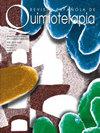血液培养和腹腔内样本中的非念珠菌分离株:数据来源于马德里进行的一项多中心前瞻性研究。
IF 1.9
4区 医学
Q4 MICROBIOLOGY
Revista Espanola De Quimioterapia
Pub Date : 2023-10-01
Epub Date: 2023-06-26
DOI:10.37201/req/025.2023
引用次数: 0
摘要
本文章由计算机程序翻译,如有差异,请以英文原文为准。

Non-Candida isolates from blood cultures and intra-abdominal samples: data derived from a multicentre prospective study conducted in Madrid.
from blood cultures (n=12) or intra-abdominal samples (n=13; peritoneal samples [n=11], liver samples [n=2]) that represented 1.1% (n=12/1,101) and 1.3% (n=13/1,031) of isolates from blood cultures and intra-abdominal samples, respectively (Figure 1). Non-Candida yeasts were found in 1.3 % (n=25/1,912) of the patients (Candida spp were simultaneously found in 8/25 patients). Interestingly, higher species diversity was found in isolates from blood cultures; the species found in intra-abdominal samples were also found in blood culture isolates except for S. cerevisiae, which was exclusively found in intra-abdominal samples. Blood-cultured isolates were mainly sourced from patients in medical (42%) or ICU wards (33%), whereas intra-abdominal isolates were mainly sourced from patients in surgery wards (77%). The number of isolates detected per year were 12 in 2019, 8 in 2020, and 5 in 2021.
求助全文
通过发布文献求助,成功后即可免费获取论文全文。
去求助
来源期刊
CiteScore
2.90
自引率
10.50%
发文量
146
审稿时长
>12 weeks
期刊介绍:
The official journal of the Sociedad Española de Quimioterapia (Spanish Society of Chemotherapy), publishes articles that further knowledge and advance the science and application of antimicrobial chemotherapy with antibiotics and antifungal, antiviral and antiprotozoal agents primarily in human medicine. Authors sign an exclusive license agreement, where authors have copyright but license exclusive rights in their article to the Publisher. All manuscripts are free open access. Revista Española de Quimioterapia includes the following sections: reviews, original articles, brierf reports, letters, and consensus documents.

 求助内容:
求助内容: 应助结果提醒方式:
应助结果提醒方式:


